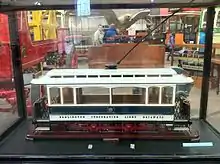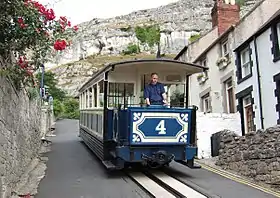Three foot six inch gauge railways in the United Kingdom
One of the first railways using 3 ft 6 in (1,067 mm) gauge track was the Little Eaton Gangway in England, constructed as a horse-drawn wagonway in 1795. Other 3 ft 6 in (1,067 mm) gauge wagonways in England and Wales were also built in the early 19th century. Also during this time, numerous tram networks were built in 3 ft 6 in (1,067 mm) gauge (see table below).
| Track gauge | ||||||||||||||||||||||||||||||||||||||||||||||||||||||||||||||||||||||||||||||||||||||||
|---|---|---|---|---|---|---|---|---|---|---|---|---|---|---|---|---|---|---|---|---|---|---|---|---|---|---|---|---|---|---|---|---|---|---|---|---|---|---|---|---|---|---|---|---|---|---|---|---|---|---|---|---|---|---|---|---|---|---|---|---|---|---|---|---|---|---|---|---|---|---|---|---|---|---|---|---|---|---|---|---|---|---|---|---|---|---|---|---|
| By transport mode | ||||||||||||||||||||||||||||||||||||||||||||||||||||||||||||||||||||||||||||||||||||||||
| By size (list) | ||||||||||||||||||||||||||||||||||||||||||||||||||||||||||||||||||||||||||||||||||||||||
|
||||||||||||||||||||||||||||||||||||||||||||||||||||||||||||||||||||||||||||||||||||||||
| Change of gauge | ||||||||||||||||||||||||||||||||||||||||||||||||||||||||||||||||||||||||||||||||||||||||
| By location | ||||||||||||||||||||||||||||||||||||||||||||||||||||||||||||||||||||||||||||||||||||||||
 |
||||||||||||||||||||||||||||||||||||||||||||||||||||||||||||||||||||||||||||||||||||||||

The Little Eaton Gangway in 1908 with the last train of loaded coal wagons.

Model of a Darlington Corporation Light Railways tramcar at the National Tramway Museum.

The Great Orme Tramway, a street-running funicular.

Railways
See also
References
- Silkstone Waggonway, South Yorkshire: Survey Report (PDF). 1. Yorkshire Archaeological Trust. August 2012.
This article is issued from Wikipedia. The text is licensed under Creative Commons - Attribution - Sharealike. Additional terms may apply for the media files.

